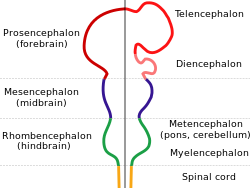Loading AI tools
Part of the embryonic brain From Wikipedia, the free encyclopedia
The hindbrain, rhombencephalon (shaped like a rhombus) or lower brain[1] is a developmental categorization of portions of the central nervous system in vertebrates. It includes the medulla, pons, and cerebellum. Together they support vital bodily processes.[2]
| Hindbrain | |
|---|---|
 | |
 Scheme of the roof of the fourth ventricle. | |
| Identifiers | |
| MeSH | D012249 |
| NeuroNames | 540 |
| NeuroLex ID | birnlex_942 |
| TA98 | A14.1.03.002 |
| FMA | 67687 |
| Anatomical terms of neuroanatomy | |
Rhombomeres Rh3-Rh1 form the metencephalon.
The metencephalon is composed of the pons and the cerebellum; it contains:
Rhombomeres Rh8-Rh4 form the myelencephalon.
The myelencephalon forms the medulla oblongata in the adult brain; it contains:
The hindbrain is homologous to a part of the arthropod brain known as the sub-oesophageal ganglion, in terms of the genes that it expresses and its position in between the brain and the nerve cord.[3] It has been suggested that the hindbrain first evolved in the urbilaterian—the last common ancestor of chordates and arthropods—between 570 and 555 million years ago.[3][4]
A rare brain disease of the cerebellum is rhombencephalosynapsis characterized by an absent or partially formed vermis. Symptoms can include truncal ataxia. The disorder is a main feature of Gomez-Lopez-Hernandez syndrome.
Seamless Wikipedia browsing. On steroids.
Every time you click a link to Wikipedia, Wiktionary or Wikiquote in your browser's search results, it will show the modern Wikiwand interface.
Wikiwand extension is a five stars, simple, with minimum permission required to keep your browsing private, safe and transparent.